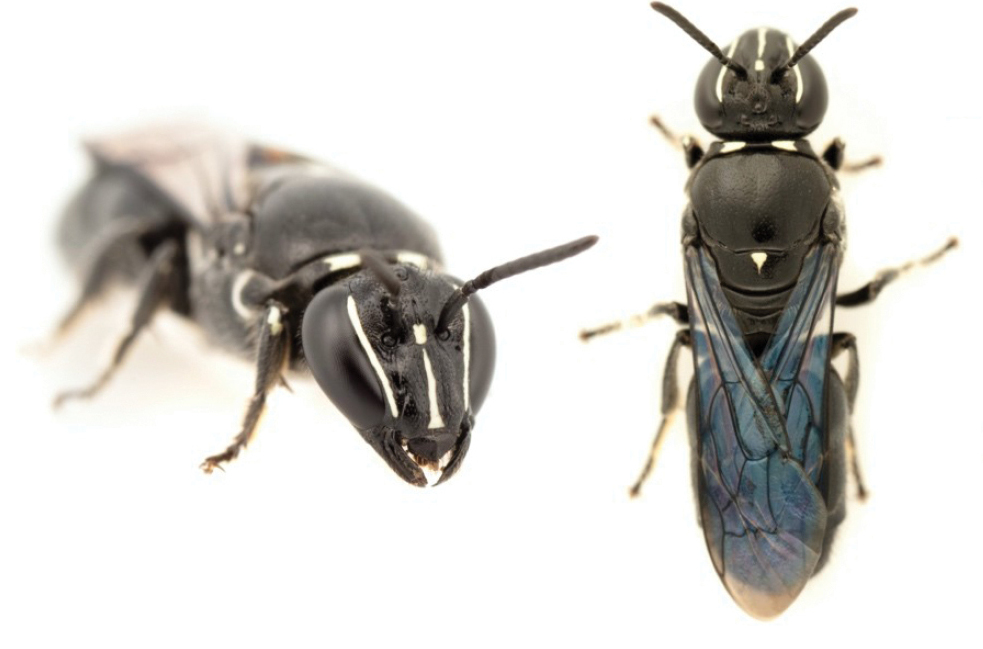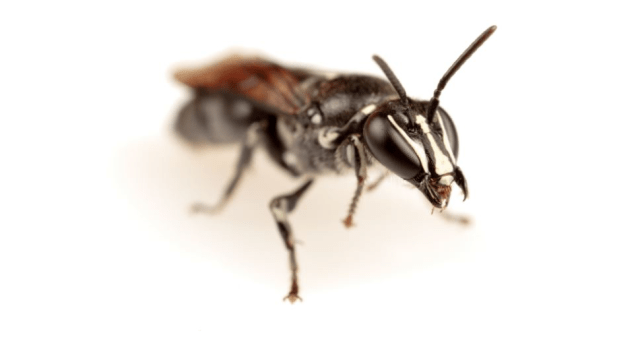Not since 1923 have scientists gazed upon the Australian cloaked bee. That is, until recently when scientists located a few populations in the wild. But its rediscovery comes as a mixed blessing owing to its potentially threatened status.
Six. That’s it — just six.
Only six individuals of this species, Pharohylaeus lactiferus, have ever been seen until recently, and none since 1923, when one of these handsome fellows was spotted in Queensland, Australia. These rare bugs are commonly referred to as cloaked bees on account of their cloak-like abdominal segments.
Scientists, fearful that the species had gone the way of the dodo, launched a last-gasp investigation to find out. The good news is that some specimens were actually spotted, but the bad news is that they’re likely in really big trouble on account of extensive habitat loss. Entomologist James Dorey, a PhD student at Flinders University, is the lone author of a new paper describing the re-discovery of this species, which now appears in the Journal of Hymenoptera Research.

“It’s not often you get to cast your eyes on a creature feared to be long-gone,” wrote Dorey in a commentary published at the Conversation. “I found the cloaked bee P. lactiferus during a major east coast sampling effort of more than 225 unique sites. The discovery, and what I learnt from it, helped me find more specimens at two additional sites.”
In total, Dorey managed to find three populations of cloaked bees in New South Wales and Queensland, and he found them by sampling their favourite plant species.
“I only found P. lactiferus on two types of plant: the firewheel tree and the Illawarra flame — both of which boast exuberant red flowers,” he wrote.
All cloaked bees spotted by Dorey were found within 660 feet (201 meters) of these plants, which are only found in tropical or subtropical rainforests. The bees paid attention to these plants at the “exclusion of other available floral resources,” indicating possible floral and habitat specialisation, according to the paper.
These results are concerning as it suggests the bees are suffering from population isolation; Dorey attributes the rarity of these bees to a highly fragmented habitat and the bees’ preference for these two plants. The habitat specialisation of the cloaked bee suggests it has an “above-average level of vulnerability to disturbances, particularly if it needs a strict set of requirements to make it through its entire life-cycle,” wrote Dorey at the Conversation.
That habitat loss is a major factor here is hardly surprising. Australia has lost 40% of its forest and woodland areas since the onset of European colonisation. And as the new research points out, the bees are particularly vulnerable to bushfires. That’s upsetting news given how vulnerable Australia is to bushfires, as witnessed by the devastating fires of 2019-20 that, among other things, wiped out or impacted an estimated 3 billion animals and destroyed sites sacred to Indigenous groups that also filled important ecological functions. Bushfire risk is also rising as the climate heats up, making catastrophic fire conditions more likely.
Australia hosts 1,654 named species of native bee. The potential loss of the cloaked bee is significant, however, in that it’s the lone representative of an entire genus: Pharohylaeus.
[referenced id=”1225029″ url=”https://gizmodo.com.au/2020/06/a-record-number-of-bees-died-last-summer/” thumb=”https://gizmodo.com.au/wp-content/uploads/2020/06/23/zxichi0ktum0ujpl0jto-300×168.jpg” title=”A Record Number of Bees Died Last Summer in the Northern Hemisphere” excerpt=”It’s been a bad year for bees. According to the preliminary results of the University of Maryland’s annual survey, U.S. beekeepers lost 43.7% of their honey bees from April 2019 to April 2020. That’s the second highest rate of decline the researchers’ have observed since they started the survey in…”]
Now, it’s possible that more cloaked bees are buzzing around Australia, including in places scientists aren’t looking, such as the rainforest canopy. But that’s a potential problem, said Dorsey, as rainforests are “notoriously hard to sample.”
“P. lactiferus persists, which is wonderful,” he wrote. “Unfortunately, we can’t yet say whether or not it is threatened.”
What’s required, he says, is a “robust, extensive and targeted survey regime.” Only then will we know the true status of these rare and beautiful insects.
